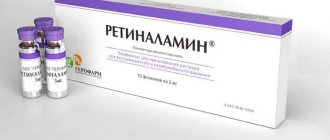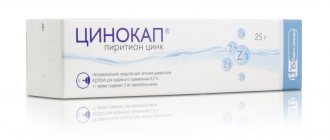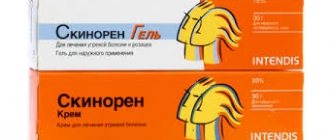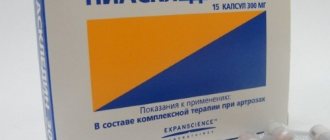| Composition and release form How the drug works When prescribed (indications) How to use (dosage) Contraindications for use Side effects of use | Overdose symptoms Drug interactions What to pay attention to Lucentis analogs Prices in pharmacies Reviews from people who have used it |
Effect of the drug
The active component of the solution, ranibizumab, is a humanized antibody fragment of endothelial growth factor A expressed by Escherichia coli (a recombinant strain) that inhibits angiogenesis.
There is a selective connection between the substance ranibizumab and isoforms of vascular endothelial growth factor, VEGF-A and others, which prevents their interaction with receptors on the surface of endothelial cells. This helps to suppress the process of neovascularization and vascular proliferation. The use of Lucentis solution stops the growth of newly formed vessels and inhibits the development of age-related macular degeneration.
With the use of the drug, a persistent decrease in the thickness of the retina is observed, which is confirmed by coherence tomography data.
Monthly injection of the solution into the vitreous helps to achieve maximum concentration in the blood plasma, which is sufficient for a long-term therapeutic effect.
The main cause of vision loss in patients over 65 years of age is neovascular age-related macular degeneration (AMD) [1]. The neovascular form of AMD is characterized by rapid progression, leading to irreversible vision loss (within a year), and the therapeutic window for starting treatment is 12 months from the onset of the disease [2]. According to the Framingham Study, the incidence of AMD in people aged 52-64 years in the United States is 1.2%, and in people over 75 years of age this figure increases to 20%. According to the BDES study, the incidence of AMD in people 75 years of age and older is 37%. The reasons for the development of the disease are complex and to this day remain not fully understood [1, 4, 6]. Currently, the main cause of the disease is considered to be genetic defects, which are realized in the form of degeneration of the choriocapillaris, Bruch's membrane and retinal pigment epithelium in the macula. Violation of the transport capacity of these structures leads to a deterioration in the supply of the outer layers of the retina with nutrients and a disruption in the removal of metabolic products from it, which gradually accumulate [2]. One of the factors in the development of the wet form of AMD is the increased formation of a protein—cocystic endothelial growth factor (VEGF-A) [4, 6]. This factor, under hypoxic conditions, triggers the formation of new pathological vessels under the macula. Due to the defective walls of such vessels, plasma and blood cells escape into the adjacent retinal tissue, which leads to local retinal detachment and the inevitable death of its photoreceptors - rods and cones. Protein exudate and hemorrhages aggravate the situation, leading to the formation of a rough scar in the macular region of the retina and irreversible deterioration of vision. The outcome of the disease is a gross dysfunction of the central part of the retina (macula) and a sharp decrease in central vision [1].
Vision loss negatively affects the quality of life of a patient with AMD. Compared to clinically healthy individuals, patients with bilateral AMD stop activities requiring vision more quickly (by 45%), their health deteriorates more often (by 13%) and depression occurs (by 42%) [2].
Many ophthalmologists have high hopes for new treatments for AMD using new biotechnological drugs (Visudin, Macugen, Lucentis), which can prevent irreversible blindness. If previously the diagnosis of neovascular AMD had a pessimistic prognosis for vision, and the treatment (drug, laser, surgery) could only slow down the progression of the disease, now there is a real opportunity to help such patients and improve their quality of life [3].
The most effective of the new drugs is Lucentis (Ranibizumab), which belongs to the group of angiogenesis inhibitors. It suppresses the activity of VEGF-A, prevents the growth of pathological vessels and leads to a reduction in retinal edema, and therefore to restoration of retinal thickness and structure [5, 7].
The drug is registered as a solution for intraocular administration by the Federal Service for Surveillance in Healthcare and Social Development of the Ministry of Health and Social Development of the Russian Federation (registration certificate LSR - 004567/08 dated June 16, 2008). The course of treatment with Lucentis consists of two stages: a stabilization phase (mandatory) - three monthly injections and a maintenance phase (as needed) - therapy based on disease progression with monthly assessment of visual acuity.
Lucentis is administered intravitreally at a dose of 0.5 mg; the first 3 injections are performed within 3 months with a frequency of 1 time per month with control examinations (VIS, OCT), subsequent injections are prescribed individually. The manipulation is performed by an ophthalmic surgeon of appropriate qualifications under local anesthesia, on an outpatient basis.
The effectiveness of the drug has been proven by international multicenter studies (MARINA, ANCHOR - more than 1100 patients). In both studies, the main criterion for the effectiveness of treatment was the proportion of patients whose vision remained stable (i.e., over the 12 months of the study, the number of letters read decreased by no more than 15 compared to the initial level according to the ETDRS table) [4, 6].
MARINA was a multicenter, randomized, double-blind, placebo-controlled, phase III trial of 716 patients with minimal classic or occult neovascular membranes. Patients received Lucentis injections or sham injections every month for 2 years [6].
ANCHOR was a multicenter, randomized, double-blind, controlled phase III trial involving 423 patients with predominantly classical membranes [4]. Patients received injections of Lucentis or placebo every month for 24 months and photodynamic therapy with Verteporfin (Visudin) from day 1 and every 3 months as needed (determined by evaluation of fluorescein angiograms).
According to the MARINA study, over 2 years, 90% of patients treated with Lucentis maintained or improved visual acuity (less than 15 letters lost) compared with 53% of patients in the placebo group. According to a quality of life study using the Visual Function Questionnaire-25 (VFQ-25) of the National Eye Institute, an improvement in visual function in terms of daily activities (reading, driving) was recorded. A 3-line improvement in ETDRS vision in 30% of patients corresponds to a 10-point improvement in VFQ-25. Each returned line in the visual acuity assessment for the patient means an improvement in the quality of life in terms of daily activities. Lucentis provides a high safety profile: when administered monthly, the concentration of Lucentis in the systemic circulation is too low to affect the normal function of VEGF-A outside the eye; the drug is quickly eliminated from the body, as it is an antibody fragment. Most ophthalmological side effects were transient and related to the drug administration procedure; according to the MARINA, ANCHOR studies, the risk of suspected endophthalmitis was 0.05%, i.e. in 5 cases out of 10,443 injections.
In the ANCHOR study, 96% of patients treated with Lucentis maintained or improved their vision at 1 year, compared with 64% of patients treated with Visudin. During treatment with Lucentis, the risk of complications (inflammatory reactions, hemorrhages, lens opacification) compared with patients receiving Visudin is significantly less and does not exceed 1.3%. Lucentis provides rapid and long-term vision improvement regardless of the type of neovascularization. An important condition for effective treatment is the earliest possible start of treatment after detection of clinical and morphological changes characteristic of the neovascular form of AMD. If treatment is started later, its effectiveness will be reduced due to irreversible changes in the retina.
In 2008, on the basis of the State Autonomous Institution of the Tyumen Region “Regional Ophthalmological Dispensary”, the technique of intravitreal administration of the drug Lucentis to patients with the wet form of AMD was mastered and introduced. By Decree of the Government of the Tyumen Region No. 134p dated April 25, 2011 “On introducing amendments and additions to Decree No. 377-p dated December 28, 2009,” the drug Ranibizumab (Lucentis) was included in the Formulary of Medicines, Medical Products and Consumables during the implementation of the territorial program.
Order of the Department of Health of the Tyumen Region No. 181 OS dated May 31, 2011 approved the “Regional standard for the provision of specialized outpatient medical care in the Tyumen Region to patients diagnosed with degeneration of the macula and posterior pole,” which we developed.
The purpose of the work is to analyze the experience of using the drug Lucentis in patients with the wet form of AMD on the basis of the State Autonomous Institution of the Tyumen Region "Regional Ophthalmological Dispensary".
Material and methods
In the period 2009-2011. Intravitreal injection of Lucentis was performed in 35 patients. Follow-up period: 24 months.
The average age of the patients was 50±6.2 years. All patients were of working age. Lucentis was administered intravitreally at a dose of 0.5 mg (0.05 ml) once a month consistently for 3-4 months (20 patients received 3 injections with an interval of 1 month, the rest received 1-2 injections according to indications). A total of 71 injections were performed.
During the examination, along with traditional ones, additional research methods were carried out: fundus photography, optical coherence tomography (OCT) of the retina and fluorescein angiography of the retina.
Results and discussion
An important contribution to ensuring the availability of high-tech care for patients with wet AMD in the Tyumen region was the development and implementation of a regional standard for the provision of specialized outpatient medical care, as a result of which this type of care began to be provided free of charge at the expense of compulsory medical insurance. The criterion for selecting patients for treatment was only medical indications, and not their financial capabilities. We believe that this has opened up new possibilities for the use of Lucentis and improved the quality of ophthalmological care.
The regional standard model is shown below.
Regional standard for the provision of specialized outpatient medical care in the Tyumen region to patients diagnosed with macular and posterior pole degeneration
Patient model:
№1
Age category:
adults
Nosological form:
degeneration of the macula and posterior pole (age-related macular degeneration, neovascular syndrome)
ICD-10 code:
N35.3, N36.0, N35.2
Phase:
chronic
Stage:
exudative, neovascular
Complications:
choroidal neovascularization, membrane with subfoveal localization
Selection criteria:
somatic indications:
chronic diseases in remission, cardiovascular diseases, diabetes mellitus in compensation stage
social indications:
a patient who understands the need for treatment and has the opportunity for regular monitoring
Conditions and level of provision:
specialized outpatient care (one-day outpatient surgery), by decision of the medical commission
Average delivery time:
15 days
According to the data obtained, the effectiveness of treatment was 100%, i.e. In all 35 patients, vision loss was prevented and it was significantly improved. Visual acuity in patients with wet AMD before treatment was 0.13±0.05, after treatment - 0.44±0.06; Thus, the increase in visual acuity during treatment was 0.31±0.07.
The initial retinal thickness was 313.2±21.3 µm, after 1 injection of Lucentis - 241.6±11.5 µm, after 2 and 3 - 231.1±7.2 and 228.2±10.1 µm, respectively. As a result of the study, it turned out that a pronounced clinical and anatomical response was achieved after the first injection of Lucentis, then positive dynamics were observed throughout the entire observation period.
Positive treatment results are confirmed by the dynamics of OCT tomograms, which is illustrated by the clinical examples below.
Clinical example 1.
Patient M., born in 1938, complained of distortion of objects in front of her left eye, which appeared more than 3 months ago. Upon treatment: VisОD=0.02 cannot be corrected; OS=0.1 with corr. –3.0=0.2; IOP 17.0/18.0 mm Hg.
Diagnosis: AMD OD (scar stage); AMD OS, SUI, edema stage.
The dynamics of OCT tomograms of patient M. during treatment with Lucentis is shown in Fig. 1.
Figure 1. Dynamics of OCT tomograms of patient M. during treatment with Lucentis. a — initially Vis OS=0.1 with corr. –3.0=0.2; b — after the 1st injection Vis OS=0.1 s corr. –3.0=0.4; c — after the 2nd injection Vis OS=0.1 with corr. –3.0=0.5; d — after the 3rd injection Vis OS=0.1 with corr. –3.0=0.4.
Clinical example 2.
Patient O., born in 1937, complained of distortion of objects in front of her left eye. Vis OD=0.09 with corr. +3.0 diopters sul –6.5 diopters = 0.4; OS=0.07 with corr. +2.5 diopters sul –8.0 diopters =0.3; IOP 19.0/19.0 mmHg. Art.
Diagnosis: AMD in both eyes. Latent SUI, active phase of the left eye.
Mixed astigmatism, mild amblyopia in both eyes.
The dynamics of OCT tomograms of patient O. during treatment with Lucentis is shown in Fig. 2.
Figure 2. Dynamics of OCT tomograms of patient O. during treatment with Lucentis. a — initially Vis OS=0.07s corr.+2.5 diopters sul –8.0 diopters=0.3; b — after the 1st injection Vis OS=iden; c — after the 2nd injection Vis OS=0.07 with corr.+2.5 diopters sul –8.0 diopters=0.4; d — after the 3rd injection Vis OS=iden.
Clinical example 3.
Patient R., born in 1939, complained of decreased vision and distortion of objects in front of the left eye, which arose more than 5 months ago. Upon treatment: Vis ОD=0.04 not corrected, OS=0.1 with correction. –4.0=0.3; IOP 17.0/18.0 mm Hg.
Diagnosis: initial cataract, AMD of both eyes, complicated by a stage IV macular hole on the right, on the left - latent, active SLM with a threat of rupture.
The dynamics of OCT tomograms of patient R. during treatment with Lucentis is shown in Fig. 3.
Figure 3. Dynamics of OCT tomograms of patient R. during treatment with Lucentis. a — initially Vis OS=0.1 with corr. –4.0 diopters=0.3; b — after the 1st injection Vis OS=0.1 s corr. –4.0 diopters=0.5; c — after the 2nd injection Vis OS=0.1 with corr. –4.0 diopters=0.5; d — after the 3rd injection Vis OS=0.1 with corr. –4.0 diopters=0.4
Thus, during treatment with Lucentis, retinal edema, neovascularization and fibrosis decreased, and retinal architecture was restored.
All patients receiving Lucentis had no unwanted side effects or complications.
conclusions
Thus, therapy with Lucentis significantly improves the visual prognosis of patients with wet AMD, allows not only to maintain, but also to improve visual acuity, improve the quality of life of patients and prevent disability.
The introduction of a regional standard for the provision of specialized outpatient medical care in the Tyumen region made the use of Lucentis available in patients with wet AMD and improved the quality of ophthalmological care.
Directions for use and dosage
Lucentis solution is intended for injection into the vitreous body. The bottle is designed for one injection, which should be performed by a qualified ophthalmologist with sufficient experience in such procedures.
The dosage of the administered solution is 0.05 ml, the frequency of injections is monthly, once. In one procedure, the drug is administered into one eye. The frequency of drug injections throughout the year is determined by the attending physician.
Therapy with Lucentis requires regular monitoring of IOP and visual acuity.
Precautions when using the drug
The drug should only be administered by an ophthalmologist with sufficient experience in intravitreal injections. Injections require compliance with the rules of asepsis and antisepsis.
Within a week after administration of the solution, the patient needs medical supervision to prevent possible complications. If any undesirable changes occur, you should immediately consult a doctor.
Lucentis is not administered to both eyes at the same time to avoid the development of serious side effects. During treatment with the drug, you should give up alcohol.
During treatment with the drug, some visual impairments are possible, which negatively affect the patient’s ability to drive vehicles and work with moving mechanisms.
Other reviews after Lucentis injection
Veronika Yakovleva with her mother Anastasia Petrovna
We already had our second injection of the drug. There's a third one coming up in a month. We do it because of diabetes, a spot appeared in front of the eye, as it turned out during the examination, the diagnosis was “wet form of macular degeneration of the right eye.” Vision began to noticeably improve about a week after the first injection, not quickly, however, but we are happy about it.
The injection itself is not painful, there is a slight discomfort after the frost “releases” + you need to drip antibacterial drops for several days. Of course, one cannot say that all this is “pleasant,” but what can you do? You have to be patient in order to preserve your vision.
We are quite satisfied with the treatment of doctors and administrators - everyone is friendly and, which is very important for us, they explain everything “on their fingers” so that ordinary people can understand it: they show videos and draw diagrams on pieces of paper, answer our “stupid questions” - they are very patient (there are What to compare with - we were observed for a long time with diabetic retinopathy in the district clinic.
View the official instructions for Lucentis (PDF)







